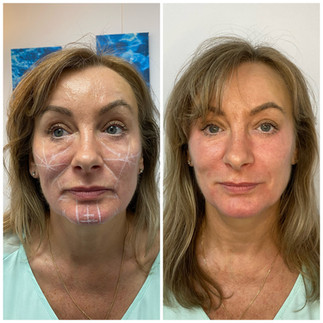Facial Collagen Banking - Why & how to start today?
- Amrit Thiara
- Aug 23, 2023
- 3 min read
Skin laxity, also known as skin looseness, refers to the loss of firmness and elasticity in the skin.
It is a natural consequence of the aging process, but various factors can contribute to its development. Skin laxity occurs when the collagen and elastin fibers in the skin weaken, causing it to sag, wrinkle, and appear less toned. The primary cause of skin laxity is the natural breakdown of collagen and elastin fibers over time. These fibers provide support and structure to the skin, giving it a youthful and firm appearance. As we age, the production of collagen and elastin gradually decreases, making the skin thinner and less resilient.
Why is Collagen Important?
Collagen, according to dermatologists, is the building block of protein that gives one baby skin and plumpness. Production of collagen starts to dwindle in our mid-to-late 20s and early 30s and we start losing 1% of our collagen per year after that, which the body does not naturally replace unless stimulated. By 40, collagen drops dramatically, leading to signs of aging such as wrinkles, skin sagging, skin drying and loss of energy. Due to other factors like pollution, stress, sun exposure, smoking, poor diet, genetics and other toxins, the breakdown of essential collagen and fiber's can be accelerated.
While collagen can be found in one’s daily diet such as fish and vegetables, it is not enough to compensate for what is lost as you age. Having enough collagen in the body keeps skin, hair and nails healthy with a high level of energy and vitality.
How does it affect us?
Skin laxity can affect any area of the body, but it is commonly observed in the face, neck, arms, and abdomen. It can manifest as jowls, sagging cheeks, loose skin on the neck, and the formation of wrinkles and folds.
Furthermore, weight loss, pregnancy, and a sedentary lifestyle can contribute to skin laxity as they cause rapid changes in body contour and muscle tone.

Treatments used for Collagen Banking
Fortunately, several treatments are available to address skin laxity and restore a more youthful appearance.
Skin laxity is a natural part of the aging process, but its impact can be minimized through proper care and various treatments.
Musts Dos-
Sun Protection SPF50 daily
Regular Exercise
Hydration
Balanced Diet rich in nutrients
Avoid smoking, binge drinking
Quality skincare using Hyaluronic acid & Retinols
Non-invasive techniques such as laser resurfacing, radiofrequency therapy, and ultrasound treatments can stimulate collagen production and tighten the skin. These procedures aim to improve elasticity, increase skin thickness, and reduce the appearance of wrinkles. Many repeated sessions are needed with these treatments to keep on top of the results which can last a few months.
Injectables such as skin boosting injections like Profhilo are a maximum boost of collagen and maintaining this treatment on a yearly basis can reverse sun damage and promote collagen stimulation like no other! Improved skin laxity, plumpness, hydration, tightening and natural skin glow can be seen. Dermal fillers can not only stimulate the collagen and elastin in the skin but also replace volume loss to plump skin in areas of volume loss. These treatments are worth the investment as last 1-2 years on average and don't tend to break the bank.

Surgical interventions like facelifts, neck lifts, and tummy tucks are also viable options for individuals who wish to treat skin laxity which cannot be treated without surgery.
Maintaining a healthy lifestyle can significantly help prevent or slow down skin laxity.
Understanding the causes and available options is essential for anyone concerned about maintaining firm, youthful skin.
Consultation with our Cosmetic Doctors in clinic will provide an individualised approach to address skin laxity and help individuals regain confidence in their appearance.

Book in today for a consultation from the comfort of your home. Complete our FREE online Consultation form and our Doctors will get back to you!
.jpg)













Comments